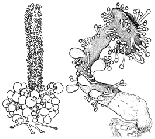Deep-Sea taxon details
Candelabridae Stechow, 1921
1595 (urn:lsid:marinespecies.org:taxname:1595)
accepted
Family
marine, fresh, terrestrial
recent only
Stechow, E. (1921d). Neue Genera und Species von Hydrozoen und anderen Evertebraten. <em>Archiv für Naturgeschichte.</em> 87: 248-265., available online at https://www.biodiversitylibrary.org/page/45494398
page(s): 248 [details]
page(s): 248 [details]
Status Stechow (1921: 248) pointed out that the genus Candelabrum de Blainville, 1830 has priority over Myriothela Sars, 1850....
Status Stechow (1921: 248) pointed out that the genus Candelabrum de Blainville, 1830 has priority over Myriothela Sars, 1850. Consequently, he then also changed the family name from Myriothelidae Hincks, 1868 to Candelabridae Stechow, 1921. According to the ICZN [4th ed. 1999, 40.2] such a name change is valid if it was made before 1961 and if the new name has been widely used. The name Candelabridae
has only recently come into usage (e. g. Bouillon, 1985; Schuchert, 1996; Hewitt & Goddard, 2001; Schuchert, 1996, 2006, 2012), while other used Myriothelidae (e. g. Calder, 1972; Millard, 1975; Petersen, 1990). I therefore suggest that for the sake of nomenclatural stability,
Candelabridae should be used. This name matches the genus name and it is also used in several large electronic databases. If in future Candelabridae should not become the prevailing name, then a ruling of the International Commission on Zoological Nomenclature must be requested. [details]
has only recently come into usage (e. g. Bouillon, 1985; Schuchert, 1996; Hewitt & Goddard, 2001; Schuchert, 1996, 2006, 2012), while other used Myriothelidae (e. g. Calder, 1972; Millard, 1975; Petersen, 1990). I therefore suggest that for the sake of nomenclatural stability,
Candelabridae should be used. This name matches the genus name and it is also used in several large electronic databases. If in future Candelabridae should not become the prevailing name, then a ruling of the International Commission on Zoological Nomenclature must be requested. [details]
Schuchert, P. (2024). World Hydrozoa Database. Candelabridae Stechow, 1921. Accessed through: Glover, A.G.; Higgs, N.; Horton, T. (2024) World Register of Deep-Sea species (WoRDSS) at: https://marinespecies.org/deepsea/aphia.php?p=taxdetails&id=1595 on 2024-04-23
Glover, A.G.; Higgs, N.; Horton, T. (2024). World Register of Deep-Sea species (WoRDSS). Candelabridae Stechow, 1921. Accessed at: https://marinespecies.org/deepsea/aphia.php?p=taxdetails&id=1595 on 2024-04-23
Date
action
by
2004-12-21 15:54:05Z
created
db_admin
original description
Stechow, E. (1921d). Neue Genera und Species von Hydrozoen und anderen Evertebraten. <em>Archiv für Naturgeschichte.</em> 87: 248-265., available online at https://www.biodiversitylibrary.org/page/45494398
page(s): 248 [details]
context source (Hexacorallia) Fautin, Daphne G. (2013). Hexacorallians of the World. (look up in IMIS) [details]
basis of record Hayward, P.J. & J.S. Ryland (Eds.). (1990). The marine fauna of the British Isles and North-West Europe: 1. Introduction and protozoans to arthropods. <em>Clarendon Press: Oxford, UK.</em> 627 pp. (look up in IMIS) [details] Available for editors
additional source Howson, C.M. & B.E. Picton. (1997). The species directory of the marine fauna and flora of the British Isles and surrounding seas. <em>Ulster Museum Publication, 276. The Ulster Museum: Belfast, UK. ISBN 0-948150-06-8.</em> vi, 508 (+ cd-rom) pp. (look up in IMIS) [details] Available for editors
status source Schuchert, P. (2006). The European athecate hydroids and their medusae (Hydrozoa, Cnidaria): Capitata Part 1. <em>Revue suisse de Zoologie.</em> 113: 325-410., available online at https://www.biodiversitylibrary.org/page/41227513 [details]
status source Nawrocki, A. M., Schuchert, P., & Cartwright, P. 2010. Phylogenetics and evolution of Capitata (Cnidaria: Hydrozoa), and the systematics of Corynidae. Zoologica Scripta 39(3): 290-304. [details]
page(s): 248 [details]
context source (Hexacorallia) Fautin, Daphne G. (2013). Hexacorallians of the World. (look up in IMIS) [details]
basis of record Hayward, P.J. & J.S. Ryland (Eds.). (1990). The marine fauna of the British Isles and North-West Europe: 1. Introduction and protozoans to arthropods. <em>Clarendon Press: Oxford, UK.</em> 627 pp. (look up in IMIS) [details] Available for editors
additional source Howson, C.M. & B.E. Picton. (1997). The species directory of the marine fauna and flora of the British Isles and surrounding seas. <em>Ulster Museum Publication, 276. The Ulster Museum: Belfast, UK. ISBN 0-948150-06-8.</em> vi, 508 (+ cd-rom) pp. (look up in IMIS) [details] Available for editors
status source Schuchert, P. (2006). The European athecate hydroids and their medusae (Hydrozoa, Cnidaria): Capitata Part 1. <em>Revue suisse de Zoologie.</em> 113: 325-410., available online at https://www.biodiversitylibrary.org/page/41227513 [details]
status source Nawrocki, A. M., Schuchert, P., & Cartwright, P. 2010. Phylogenetics and evolution of Capitata (Cnidaria: Hydrozoa), and the systematics of Corynidae. Zoologica Scripta 39(3): 290-304. [details]
From editor or global species database
Diagnosis Hydroid solitary or forming pseudo-colonies. Hydrocaulus short, with tubular or root-like adhesive processes, with or without perisarc. Hydranth large and elongated, covered in distal half by numerous scattered, hollow capitate tentacles, tentacles solitary or grouped adnate basally; gonophores fixed, developing on aboral part of hydranth below tentacle covered region, either directly on hydranth or on spindle-shaped blastostyles. Gonophores fixed sporosacs. [details]Status Stechow (1921: 248) pointed out that the genus Candelabrum de Blainville, 1830 has priority over Myriothela Sars, 1850. Consequently, he then also changed the family name from Myriothelidae Hincks, 1868 to Candelabridae Stechow, 1921. According to the ICZN [4th ed. 1999, 40.2] such a name change is valid if it was made before 1961 and if the new name has been widely used. The name Candelabridae
has only recently come into usage (e. g. Bouillon, 1985; Schuchert, 1996; Hewitt & Goddard, 2001; Schuchert, 1996, 2006, 2012), while other used Myriothelidae (e. g. Calder, 1972; Millard, 1975; Petersen, 1990). I therefore suggest that for the sake of nomenclatural stability,
Candelabridae should be used. This name matches the genus name and it is also used in several large electronic databases. If in future Candelabridae should not become the prevailing name, then a ruling of the International Commission on Zoological Nomenclature must be requested. [details]








